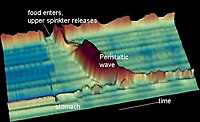
Photo from wikipedia
BACKGROUND Sarcopenia is associated with complications and inferior oncologic outcomes in solid tumors. Axial computed tomography (CT) scans can be used to evaluate sarcopenia, however manual quantification is laborious. We… Click to show full abstract
BACKGROUND Sarcopenia is associated with complications and inferior oncologic outcomes in solid tumors. Axial computed tomography (CT) scans can be used to evaluate sarcopenia, however manual quantification is laborious. We sought to validate an automated method of quantifying muscle cross-sectional area (CSA) in patients with pancreatic adenocarcinoma (PDAC). METHODS Mid-L3 CT images from patients with PDAC were analyzed: CSAs of skeletal muscle (SM) were measured using manual segmentation and the software AutoMATiCA, and then compared with linear regression. RESULTS Five-hundred-twenty-five unique scans were analyzed. There was robust correlation between manual and automated segmentation for L3 CSA (R2 0.94, P < 0.001). Bland-Altman analysis demonstrated a consistent overestimation of muscle CSA by AutoMATiCA with a mean difference of 5.7%. A correction factor of 1.06 was validated using a unique test dataset of 36 patients with non-PDAC peripancreatic malignancies. CONCLUSIONS Automated muscle CSA measurement with AutoMATiCA is highly efficient and yields results highly correlated with manual measurement. These findings support the potential use of high-throughput sarcopenia analysis with abdominal CT scans for both clinical and research purposes.
Journal Title: American journal of surgery
Year Published: 2022
Link to full text (if available)
Share on Social Media: Sign Up to like & get
recommendations!